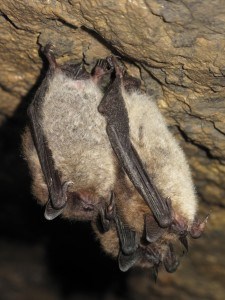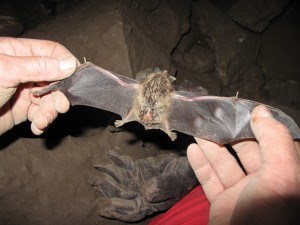

On the night of Aug. 12, 2015, Parks Canada erected a bat call recorder in Gord Ruddy’s Miette Avenue backyard. Part way through the following night, the machine had recorded so many calls its memory card ran out of space.
Of the eight bat species thought to reside or migrate in Jasper National Park, the backyard recorder picked up seven of them. The largest of all Canadian bats—the hoary bat—made an appearance, as did the more common little brown bat, one of several myotis, or “mouse-eared” species that use the park.
“It totally blew me away,” says Gord Ruddy of the results. “I thought I had a couple species, but I had no idea there would be so many.”
While the little brown bats were expected, as they are thought to be one of Jasper’s most common bats, the presence of the larger bats, like the hoary, was more surprising, says Greg Horne, a Parks Canada resource management officer. Hoary bats can be up to 14 cm tall and have a wingspan measuring the same.
“Larger bats can prefer larger insects like moths. Moths like lights at night, so it is possible that a concentration of moths in town due to our lights could be drawing in larger bats,” says Horne, adding that this is just a theory—one of many things he wants to learn about bats in the park. His curiosity about how bats use the townsite is just a small part of the work Horne has taken on to understand bat distribution across park.
The Bat Brigade
For the past several years, Horne has worked to bring Jasper National Park online with the North American Bat Monitoring Program, AKA NABat. After testing a monitoring protocol in 2014, work began in earnest last summer. The results will be part of a North America-wide data set aimed at helping those that manage landscapes with bats make effective decisions about bat conservation.
Part of the impetus for the study is the fact that two of the species that reside in Jasper, the little brown bat and the northern bat, have been federally listed as endangered species, primarily due to the plummeting of eastern populations caused by a disease known as white-nose fungus. Conservation managers are desperately trying to prevent the spread of the fungus out west.
The Bat Mobile
Horne and his team recorded bat calls at stationary sites located valley-wide from just south of Whistlers Campground, south to Wabasso Campground. They also collected recordings from a bat mobile. Yes, you read that right, a bat mobile.
Like the real bat mobile, the roof of Horne’s vehicle was adorned with high tech gadgets: microphones specially designed and tuned for the frequencies of bat calls. To capture bat calls, Horne drove from town to Athabasca Falls and back on 93A to the Whirpool River at a speed of 30 kilometres an hour—no faster, no slower.
“On a mobile transect you only want to count a bat once. Bats can’t fly over 30 kilometres an hour, so you’ll never catch the same bat twice. And if you go too fast, well, you’ll just miss them,” he says.
The monitoring at both the stationary sites and in the bat mobile has to be conducted before young bats—recently born in summer roosts—are able to fly, meaning the mothers are no further than a 10 km radius away. This allows Horne to capture their numbers before they disperse.
Like Ruddy’s backyard, the bat found most commonly in the study area was the little brown bat. The long-distance migrant, the silver-haired bat, also put in a strong showing. Calls were also heard from the hoary bat, eastern red bat, long-legged bat, long-eared bat, northern bat and big brown bat. While the results are preliminary, the detection of eight species is promising in year one of a five-year commitment to NABat.

Bat Man
Horne is clearly very fond of bats. He is an internationally renowned caver and explorer—a passion that has led him to many a bat cave.
He’s had some pretty wild experiences with bats while snaking his body through the narrow openings and curvy architecture of the karst systems that make up the vast caverns of the Rocky Mountains. While none have flown in his hair (an experience that is largely mythical), he has had them accidentally hit him while he was in a tight spot.
“They can fly by memory,” he says, adding that bats don’t always use echolocation to travel in familiar places like their cave roosts. “I wasn’t there the last time they came through,” he says with a laugh.
“Bats are highly misunderstood,” he says, pointing to all the cultural lore that paint them as rabid vampires in animal form. Though some bats do carry rabies and people should avoid handling them, the animals most likely to be attacked by bats in Jasper are insects—they consume millions nightly.
To put bat-bug-eating in human terms, Horne points to a US-based study that estimated the economic value of the pest-control services provided by bats to agriculture in the U.S. alone range from a low of $3.7 billion to a high of $53 billion a year.
Just imagine: without bats, we’d have even more mosquitos.
Horne is excited by the results of the study. He says that below treeline in the Rocky Mountain landscape, it looks likely there will be some bat activity, though there will be hot spots and some low-use areas.
It’s good news, he says.
“Bats are everywhere.”
Bat Dynasty
Mice scurrying around in the wild live for about a year or two. Based on their similar body-size, for a long time it was believed bats had a similar life span, but in recent years that myth has been largely dispelled, most recently by a bat close to home.
A little brown bat that hibernated in Cadomin Cave was aged at 39+ years, based on the length of time it had a metal band affixed to its leg. That’s a long time for an animal that size: when scaled to human size, these little guys would live twice as long as us.
For a bat to live this long, it needs to maintain its ability to echolocate, fly and maneuver rapidly in order to capture its insect prey from leaves or on the ground. It’s like a human living to be 100 and still being as agile and fast and healthy as when they were young.
The reasons for the long life of bats is not yet well understood, but scientists are working on it. Vadim Gladyshev of Harvard Medical School has suggested bats have exceptional defense mechanisms to the break down of their cells due to environmental stress (like UV radiation from the sun—a type of radiation known to contribute to aging in humans). It’s also likely that at the molecular level, bats have had key evolutionary changes to genes at play in hormonal systems, also thought to be linked to longevity.
Niki Wilson
Special to the 51°µÍř
